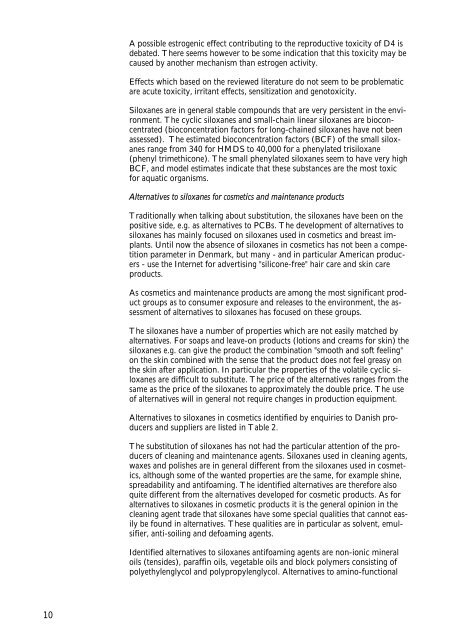No. 1031 - Miljøstyrelsen
No. 1031 - Miljøstyrelsen
No. 1031 - Miljøstyrelsen
Create successful ePaper yourself
Turn your PDF publications into a flip-book with our unique Google optimized e-Paper software.
10<br />
A possible estrogenic effect contributing to the reproductive toxicity of D4 is<br />
debated. There seems however to be some indication that this toxicity may be<br />
caused by another mechanism than estrogen activity.<br />
Effects which based on the reviewed literature do not seem to be problematic<br />
are acute toxicity, irritant effects, sensitization and genotoxicity.<br />
Siloxanes are in general stable compounds that are very persistent in the environment.<br />
The cyclic siloxanes and small-chain linear siloxanes are bioconcentrated<br />
(bioconcentration factors for long-chained siloxanes have not been<br />
assessed). The estimated bioconcentration factors (BCF) of the small siloxanes<br />
range from 340 for HMDS to 40,000 for a phenylated trisiloxane<br />
(phenyl trimethicone). The small phenylated siloxanes seem to have very high<br />
BCF, and model estimates indicate that these substances are the most toxic<br />
for aquatic organisms.<br />
Alternatives to siloxanes for cosmetics and maintenance products<br />
Traditionally when talking about substitution, the siloxanes have been on the<br />
positive side, e.g. as alternatives to PCBs. The development of alternatives to<br />
siloxanes has mainly focused on siloxanes used in cosmetics and breast implants.<br />
Until now the absence of siloxanes in cosmetics has not been a competition<br />
parameter in Denmark, but many - and in particular American producers<br />
- use the Internet for advertising "silicone-free" hair care and skin care<br />
products.<br />
As cosmetics and maintenance products are among the most significant product<br />
groups as to consumer exposure and releases to the environment, the assessment<br />
of alternatives to siloxanes has focused on these groups.<br />
The siloxanes have a number of properties which are not easily matched by<br />
alternatives. For soaps and leave-on products (lotions and creams for skin) the<br />
siloxanes e.g. can give the product the combination "smooth and soft feeling"<br />
on the skin combined with the sense that the product does not feel greasy on<br />
the skin after application. In particular the properties of the volatile cyclic siloxanes<br />
are difficult to substitute. The price of the alternatives ranges from the<br />
same as the price of the siloxanes to approximately the double price. The use<br />
of alternatives will in general not require changes in production equipment.<br />
Alternatives to siloxanes in cosmetics identified by enquiries to Danish producers<br />
and suppliers are listed in Table 2.<br />
The substitution of siloxanes has not had the particular attention of the producers<br />
of cleaning and maintenance agents. Siloxanes used in cleaning agents,<br />
waxes and polishes are in general different from the siloxanes used in cosmetics,<br />
although some of the wanted properties are the same, for example shine,<br />
spreadability and antifoaming. The identified alternatives are therefore also<br />
quite different from the alternatives developed for cosmetic products. As for<br />
alternatives to siloxanes in cosmetic products it is the general opinion in the<br />
cleaning agent trade that siloxanes have some special qualities that cannot easily<br />
be found in alternatives. These qualities are in particular as solvent, emulsifier,<br />
anti-soiling and defoaming agents.<br />
Identified alternatives to siloxanes antifoaming agents are non-ionic mineral<br />
oils (tensides), paraffin oils, vegetable oils and block polymers consisting of<br />
polyethylenglycol and polypropylenglycol. Alternatives to amino-functional

















